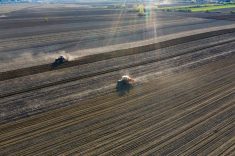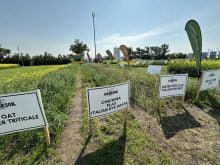[UPDATED: Oct. 6, 2021] Farmers spend a lot of time working in and on the soil. As the holder of crop nutrients and, hopefully, water, soil is literally the foundation for growing crops, although under extremely dry conditions, it may seem like just so much dirt. But aside from what a soil analysis might tell you about standard nitrogen, potassium, phosphorus and sulphur levels, do you know what’s going on in the soil and how it works?
Welcome to the world of learning about soil health. It has become a hot topic in recent years as more farmers gain awareness of the vast number of creatures that live in the soil and how the well-being of all of this microscopic life affects plant growth as well as the environment.
Tucked away in the side yard of the Chinook Applied Research Association (CARA) office building, in the southeastern Alberta community of Oyen, is a once-retired Hutterite colony schoolhouse that could use a coat of paint. But don’t let that first humble impression fool you. Inside the renovated structure, including an ATCO trailer addition, are several rooms holding sophisticated lab equipment — test tubes, microscopes, scanners, incubators, analyzers and much more — which are all used to evaluate and identify the texture as well as the biology of soil samples. Welcome to the CARA Soil Health Lab.

The lab, which opened in 2018 and is led by researcher Yamily Zavala, has one key purpose — to help farmers and others develop a better understanding of soil health, establish a benchmark of the health status of soil on individual farms and to encourage producers to develop or change management practices that benefit soil health.
Zavala studied and worked in Venezuela, where she was born and raised, and later earned a PhD in soil and plant nutrition from Cornell University. She has spent a good part of her working life studying the soil ecosystem.
“This isn’t a commercial lab,” says Zavala, although it does have cost recovery for services rendered. “It is a lab for farmers, a facility where they can come and learn about soil health and take that information home, so they can monitor soil health on their own farms.”
In one room of the lab, which was originally a classroom when the building was a school on the nearby Acadia Hutterite Colony, there are more than a dozen microscopes at work stations throughout the area. This is where farmers come to attend workshops to learn about what constitutes a healthy soil, and then they can use the microscopes to learn about the biology of soil — see the bacteria, fungi, protozoa and nematodes, for example, that will be found in samples of soil from their own farms.

They won’t be soil scientists when they complete the workshop, but they will have a basic understanding of some of the biological indicators found in the soil. They can buy their own microscopes and monitor changes in soil health on their own farms. Zavala also provides workshops to school groups, where young people can learn about what constitutes healthy soil, all the various forms of life in the soil and how that biology interacts.
“After one of the workshops with school kids, one of the farmers told me I had created a monster,” says Savala with a laugh. “His son came home after the workshop and now all he wants to do is study soil samples from the farm,” and that leads to discussion of farming practices that benefit soil health.
Read Also

Cancer agency reclassifies another herbicide ‘probably carcinogenic’
The WHO’s cancer research agency has now put atrazine, a herbicide well known to corn growers, in the same potential-hazard category where the agency put glyphosate.
Soil biology is dormant
Zavala says looking at soil samples from what might be called conventional farming practices today — zero-till seeding with three or four crops in rotation and the application of seed treatments, herbicides, fungicides and chemical fertilizer — the soil biology isn’t dead but much of it has gone dormant.
And that’s a lot of inactive creatures. Numbers vary widely but scientists estimate there may be hundreds of millions to billions of microbes in a single gram of soil — that’s like a teaspoon of dirt. The most numerous microbes in soil are bacteria, followed by actinomycetes, fungi, soil algae and soil protozoa, and let’s not forget mites, nematodes, earthworms, ants and insects that spend all or part of their lives underground. It can be, or should be, a very busy place down there.
So, what constitutes a healthy soil? There are many definitions of that too. To Zavala, it is a soil that functions as a living system, with good biodiversity and the resilience to deal with adverse conditions. With excessive moisture, for example, fields don’t flood or drown out — the soil has the capacity to receive and infiltrate the moisture.

And that all relates to proper soil aggregation. That’s defined as the arrangement of soil particles, such as sand, silt and clay, around soil organic matter. With proper aggregation, soil can resist degradation when exposed to external forces such as water and wind erosion, freezing and thawing processes and tillage.
“If I see good aggregation in the soil, that tells me the soil biology is working and making the soil more resilient,” says Zavala. “Having a soil that is well aggregated is a sign of good biological diversity. If you have that then you have a soil that is able to sequester more carbon, which reduces greenhouse gases and benefits the environment. If there is compaction in the soil, for example, that tells me the soil biology is not very happy.”
There are no silver bullets
The CARA Soil Health Lab helps farmers to understand the basics of soil biology, and through testing of soil samples establish a benchmark of the health of soils on their farms — the soil texture and biological diversity. What do they do with that information?
“I’m not here to prescribe any silver bullets or talk about extreme measures, that they have to stop doing this and start doing that,” says Zavala. “Hopefully, I can help them understand how the soil works and then from there we can work together and they can develop their own plan on how to begin the healing process.”
Some of the measures that can be used to benefit soil biology — or bring it back to life — are covered by five principles of achieving healthy soils (see sidebar for details), which includes the following:
- Minimize mechanical soil disturbance
- Keep the soils covered at all times (armour the soil)
- Grow a living root year-round
- Increase plant diversity above ground to increase diversity below
- Incorporate livestock grazing
Armed with knowledge from workshops, a microscope in the farm office, as well as support from the soil health lab, farmers are encouraged to apply new management practices and then hopefully monitor changes in soil health.
Zavala points out the CARA Soil Health Lab became a reality with a great deal of help and support from local farmers, businesses and other institutions.

*”It took a bit of convincing but seeing Savala’s enthusiasm and commitment to the idea, the CARA board of directors threw their support behind the project. Ann Rafa, who is a CARA board member, and her husband Don, bought the school from the Acadia Valley Colony some years ago, and then they sold the building to CARA and they also made a $5000 donation toward setting up the soil health lab.” Area rancher and businessman Jack Bunney, with a slow down in work projects, sent his crew of workers to help with the interior renovations of the old school.”
Bob West, of R.A. West International, who owned a then-closed lab in Vulcan, Alta., called The Soil Food Web, donated all the laboratory equipment to the CARA Soil Health Lab, which was a huge help with equipment. Support also came from the Foothills Forage Association, the Special Areas Board, the Peace Country Beef and Forage Association, the Grey Wooded Forage Association, and the Municipal District of Acadia, along with financial, material and labour donations from farms, individuals and businesses. Zavala herself has donated time and money into getting the lab up and running — apparently, she is pretty handy when it comes to tiling floors.
The CARA Soil Health Lab is working with other organizations across the province to collect soil samples to be analyzed to help add to a growing soil health database. And Zavala is also conducting field research that includes growing different crops under different treatments to determine and demonstrate practices that benefit soil health and plant growth.
For more information visit the soil health lab website at carasoilhealthlab.ca.
Five principles to improved soil health
The CARA Soil Health Lab promotes five principles to keep soil healthy, or perhaps in many cases today to bring inactive or dormant soil biology back to life. Here are a few details on what those principles might involve in terms of farming practices.
1. Minimize mechanical soil disturbance. Physical soil disturbance, such as tillage and over-grazing, can result in significant disturbance of the soil’s physical, chemical and biological properties. Soil microbial activities are also disrupted, limiting their capacity to promote crop development.
2. Keep soils covered at all times (armour the soil). Bare soil increases soil temperature. It can decrease and kill soil biological activities. Vegetation, plant residue and organic mulch protect the soil surface and feed billions of micro-organisms, which recycle nutrients and combat pest infestations to plant roots. Those micro-organisms also create soil pores where more roots can find air, nutrients and water.
3. Grow a living root year-round. Living roots will provide a food source for soil microbes (beneficial bacteria and mycorrhizal fungi). They also contribute to the formation of soil aggregates.
4. Increase plant diversity above ground to increase diversity below. Increasing plant diversity is connected to soil root diversity. Studies have shown specific soil microbes require specific plant types. Soils are more productive when there are more diverse microbial activities in the soil. Plant diversity through rotation and cocktail cover crops will support balanced and diverse soil populations that might reduce weed and pest infestations.
5. Incorporate livestock grazing. Land responds positively to the presence of livestock, provided management is appropriate. Farmers have found that using rotational grazing is the fastest and most economical way of improving the soil health. The microbial population also increases and stimulates nitrogen-fixing bacteria activities. Addition of manure and urine to the soils recycles nutrients. It is important that the grazing system will allow adequate rest for the plants between periods of grazing.
One of the primary goals to improve soil health is to increase organic matter in the soil for feeding microbes. These microbes will help to improve soil organic matter, which captures and holds more water and nutrients, growing more and larger plants, which can gather more sunlight to power the process. This constant recycling is dependent on management of the land. Following these five principles will allow the site to increase its productivity.

*Update: a quote about Ann Rafa was added.















